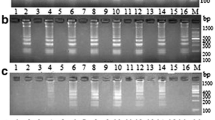Abstract
Vibrio cholerae and V. vulnificus are of major concern due to their effect on public health throughout the world. It is therefore imperative to identify a gene and method that are suitable for the accurate species-specific detection of these two species. A duplex polymerase chain reaction (PCR) assay was developed using two sets of primers targeting the groEL gene for the accurate simultaneous detection of V. cholerae and V. vulnificus. The nucleotide sequence of the groEL gene was compared with the sequences of other Vibrio and non-Vibrio species. The specificity of two primer sets for duplex PCR was checked using 24 Vibrio and 8 non-Vibrio species. The primer sets were found to be specific for these two species and could detect both of the target bacterial species without any ambiguity, even when comparing closely related species. For both species, the detection limit was 100 pg of purified genomic DNA. The duplex PCR showed high specificity and sensitivity for each species and was sufficient for the detection of V. cholerae and V. vulnificus from artificially infected shellfish tissue, flounder, and even inoculated seawater. This method is simple and cost-effective, and can be utilized for the simultaneous detection of both species, thus representing an effective tool for both epidemiologist and ecologist.




Similar content being viewed by others
References
Hsieh JL, Fries JS, Noble RT (2008) Dynamics and predictive modeling of Vibrio spp. in the Neuse River Estuary, North Carolina, USA. Environ Microbiol 10:57–64
Sack DA, Sack RB, Nair GB, Siddique AK (2004) Cholera. Lancet 363:223–233
Oliver JD (2005) Wound infections caused by Vibrio vulnificus and other marine bacteria. Epidemiol Infect 133:383–391
Jones MK, Oliver JD (2009) Vibrio vulnificus: disease and pathogenesis. Infect Immun 77:1723–1733
Oliver JD, Kaper JB (2001) Vibrio species. In: Doyle MP, Beuchat LR, Montville TJ (eds) Food microbiology: fundamentals and frontiers. ASM Press, Washington, DC
Ottaviani D, Leoni F, Rocchegiani E, Santarelli S, Masini L, Trani VD, Canonico C, Pianetti A, Tega L, Carraturo A (2009) Prevalence and virulence properties of non-O1 and non-O139 Vibrio cholerae strains from seafood and clinical samples collected in Italy. Int J Food Microbiol 132:47–53
Lalitha P, Siti Suraiya MN, Lim KL, Lee SY, Nur Haslindawaty AR, Chan YY, Ismail A, Zainuddin ZF, Ravichandran M (2008) Analysis of lolB gene sequence and its use in the development of a PCR assay for the detection of Vibrio cholerae. J Microbiol Methods 75:142–144
Han F, Ge B (2010) Multiplex PCR assay for simultaneous detection and characterization of Vibrio vulnificus strains. Lett Appl Microbiol 51:234–240
Neogi SB, Chowdhury N, Asakura M, Hinenoya A, Haldar S, Saidi SM, Kogure K, Lara RJ, Yamasaki S (2010) A highly sensitive and specific multiplex PCR assay for simultaneous detection of Vibrio cholerae, Vibrio parahaemolyticus and Vibrio vulnificus. Lett Appl Microbiol 51:293–300
Teh CSJ, Chua KH, Thong KL (2010) Simultaneous differential detection of human pathogenic and nonpathogenic Vibrio species using multiplex PCR based on gyrB and pntA genes. J Appl Microbiol 108:1940–1945
Faruque SM, Asadulghani, Saha MN, Alim AR, Albert MJ, Islam KM, Mekalanos JJ (1998) Analysis of clinical and environmental strains of nontoxigenic Vibrio cholerae for susceptibility to CTXФ: molecular basis for origination of new strains with epidemic potential. Infect Immun 66:5819–5825
Chizhikov V, Rasooly A, Chumakov K, Levy DD (2001) Microarray analysis of microbial virulence factors. Appl Environ Microbiol 67:3258–3263
Izumiya H, Matsumoto K, Yahiro S, Lee J, Morita M, Yamamoto S, Arakawa E, Ohnishi M (2011) Multiplex PCR assay for identification of three major pathogenic Vibrio spp., Vibrio cholera, Vibrio parahaemolyticus, and Vibrio vulnificus. Mol Cell Probes 25:174–176
Jeyasekaran G, Raj KT, Shakila RJ, Thangarani AJ, Sukumar D (2011) Multiplex polymerase chain reaction-based assay for the specific detection of toxin-producing Vibrio cholerae in fish and fishery products. Appl Microbiol Biotechnol 90:1111–1118
Nishibuchi M (2006) The biology of vibrios. In: Thompson FL et al (eds) Molecular identification. ASM Press, Washington, DC, pp 44–64
Yushan H, Lei L, Weijia L, Xiaoguang C (2010) Sequence analysis of the groEL gene and its potential application in identification of pathogenic bacteria. Afr J Microbiol 4:1733–1741
Hossain MT, Kim EY, Kim YR, Kim DG, Kong IS (2011) Application of groEL gene for the species-specific detection of Vibrio parahaemolyticus by PCR. Lett Appl Microbiol 54:67–72
Kim YR, Kim EY, Kim DG, Kim YO, Hossain MT, Kong IS (2012) DNA array with the groESL intergenic sequence to detect Vibrio parahaemolyticus and Vibrio vulnificus. Anal Biochem 424:32–34
Ausubel FM, Brent R, Kingston RE, Moore DD, Seidman JG, Smith JA, Struhl K (1998) Current protocols in molecular biology. Wiley, New York
Kim JS, Lee GG, Kim J, Kwon JY, Kwon ST (2008) The development of rapid real-time PCR detection system for Vibrio parahaemolyticus in raw oyster. Lett Appl Microbiol 46:649–654
Nhung PH, Ohkusu K, Miyasaka J, Sun XS, Ezaki T (2007) Rapid and specific identification of 5 human pathogenic Vibrio species by multiplex polymerase chain reaction targeted to dnaJ gene. Diagn Microbiol Infect Dis 59:271–275
Tarr CL, Patel JS, Phur ND, Sowers EG, Bopp CA, Strockbine NA (2007) Identification of Vibrio isolates by a multiplex PCR assay and rpoB sequence determination. J Clin Microbiol 45:134–140
Mollet C, Drancourt M, Raoult D (1997) rpoB sequence analysis as a novel basis for bacterial identification. Mol Microbiol 26:1005–1011
Kim DG, Kim YR, Kim EY, Cho HM, Ahn SH, Kong IS (2010) Isolation of the groESL cluster from Vibrio anguillarum and PCR detection targeting groEL gene. Fish Sci 76:803–810
Acknowledgments
This work was supported by a grant from the National Fisheries Research and Development Institute (NFRDI), Republic of Korea. Y.-R. Kim also wishes to thank Novus International, Inc. for financial support in the form of a scholarship.
Author information
Authors and Affiliations
Corresponding author
Rights and permissions
About this article
Cite this article
Hossain, M.T., Kim, YR., Kim, EY. et al. Detection of Vibrio cholerae and Vibrio vulnificus by duplex PCR specific to the groEL gene. Fish Sci 79, 335–340 (2013). https://doi.org/10.1007/s12562-012-0586-1
Received:
Accepted:
Published:
Issue Date:
DOI: https://doi.org/10.1007/s12562-012-0586-1




